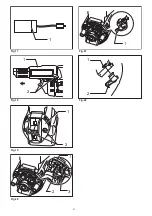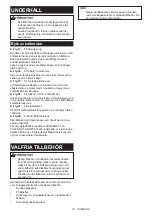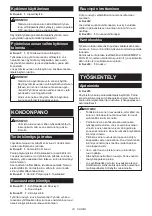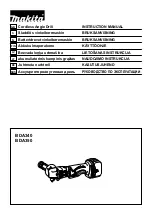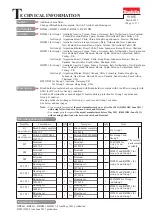
8 ENGLISH
Switch action
►
Fig.6:
1.
Switch trigger
CAUTION:
•
Before inserting the battery cartridge into the
tool, always check to see that the switch trigger
actuates properly and returns to the "OFF"
position when released.
To start the tool, simply pull the switch trigger. Release
the switch trigger to stop.
Reversing switch action
►
Fig.7:
1.
Reversing switch lever
This tool has a reversing switch to change the direction
of rotation. Depress the reversing switch lever from the
A side for clockwise rotation or from the B side for coun
-
terclockwise rotation.
When the reversing switch lever is in the neutral posi-
tion, the switch trigger cannot be pulled.
CAUTION:
•
Always check the direction of rotation before
operation.
•
Use the reversing switch only after the tool
comes to a complete stop. Changing the direc-
tion of rotation before the tool stops may dam
-
age the tool.
•
When not operating the tool, always set the
reversing switch lever to the neutral position.
ASSEMBLY
CAUTION:
•
Always be sure that the tool is switched off and
the battery cartridge is removed before carrying
out any work on the tool.
Installing or removing the bit
Loosen the thumb screws which secure the casing. Pull
out the casing in the direction of the arrow.
►
Fig.8:
1.
Casing
2.
Thumb screws
Press the dust cover toward the plane bearing and pull
out the bit. If the dust cover cannot be moved as far
as the plane bearing, try it again after turning the bit
slightly.
To install the bit, insert it into the socket while turning it
slightly. After installing, always make sure that the bit is
securely held in place by trying to pull it out.
►
Fig.9:
1.
Bit
2.
Dust cover
3.
Plane bearing
Installing screw strip
►
Fig.10:
1.
Feeder box
2.
Screw strip
3.
Screw guide
►
Fig.11:
1.
Driving position
Insert the screw strip through the screw guide. Then
insert it through the feeder box until the first screw
reaches the position next to the driving position.
Removing screw strip
To remove the screw strip, just pull it out in the direction
of the arrow.
►
Fig.12
If you depress the reverse button, you can pull out the
screw strip in the reverse direction of the arrow.
►
Fig.13:
1.
Reverse button
Carry hook
The carry hook is convenient for temporarily hooking
the tool. It can be installed on either side of the tool.
When removing the carry hook, widen it by pressing its
right ends ON BOTH SIDES in the directions of arrow
(1) and raise it in the direction of the arrow (2).
►
Fig.14:
1.
Hook
OPERATION
Driving operation
►
Fig.15
Switch on the tool by pulling the switch trigger. Hold the
tool squarely and firmly up against the driving surface. A
screw will be automatically carried to the driving posi
-
tion and fastened.
CAUTION:
•
Always check the bit carefully for wear before
driving operations. Replace a worn bit or poor
fastening may result.
•
Always hold the tool squarely against the driving
surface. Holding it at an angle may damage the
screw heads and cause wear on the bit. This
may also lead to poor fastening.
•
Always keep the tool firmly against the driving
surface until the driving is over. Failure to do so
may cause insufficient fastening of screws.
•
Be careful not to drive a screw onto another
screw already fastened.
•
Do not operate the tool without screws. It will
damage the driving surface.
•
If the feeder box does not work smoothly when
driving screws, spray car wax (spray type) on
the sliding surfaces. Never lubricate it.
Driving in corner
►
Fig.16:
1.
Wall
2.
Stopper base
This tool can be used to drive at a position 15 mm away
from the wall as shown in the figure.
CAUTION:
•
Driving at a position closer than 15 mm to the
wall or driving with the stopper base in contact
with the wall may damage the screw heads and
cause wear on the bit. This may also lead to
poor fastening of screws and malfunction of the
tool.




